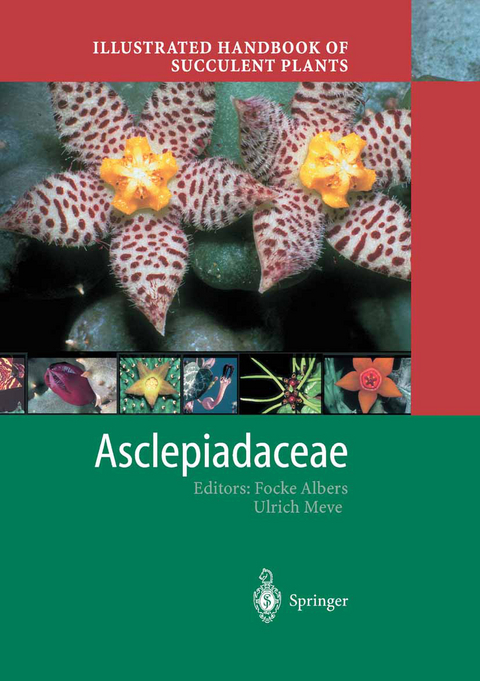
Illustrated Handbook of Succulent Plants: Asclepiadaceae
Springer Berlin (Verlag)
978-3-642-62628-9 (ISBN)
What is a Succulent ?.- How to Use This Handbook.- Scope of Information Presented.- Asclepiadaceae ? family or genus only partially covered.- Absolmsia ? family or genus completely covered (1/0).- Asclepias ? family or genus only partially covered (1/0).- Aspidoglossum ? family or genus completely covered (36/ 0).- Aspidonepsis ? family or genus completely covered (5/0).- Baynesia ? family or genus completely covered (1/0).- Brachystelma ? family or genus completely covered (122/3).- Caralluma ? family or genus completely covered (53/9).- Ceropegia ? family or genus only partially covered (160/18).- Cibirhiza ? family or genus completely covered (2/0).- Cynanchum ? family or genus only partially covered (57/4).- ×Demia ? family or genus completely covered.- Dischidia ? family or genus only partially covered (23 /1).- Dischidiopsis ? family or genus only partially covered (1/0).- Duvalia ? family or genus completely covered (18/3).- Duvaliandra ? family or genus completely covered (1/0).- ×DuvaUaranthus ? family or genus completely covered (1 /0).- Echidnopsis ? family or genus completely covered (32/4).- Edithcolea ? family or genus completely covered (1/0).- Fanninia? family or genus completely covered (1/0).- Fockea ? family or genus completely covered (6/0).- Glossostelma ? family or genus completely covered (12/0).- Hoodia ? family or genus completely covered (14/4).- ×Hoodialluma ? family or genus completely covered.- Hoya ? family or genus only partially covered (55/6).- ×Huernelia ? family or genus completely covered.- Huernia ? family or genus completely covered (67/16).- ×Huernianthus ? family or genus completely covered.- Huerniopsis ? family or genus completely covered (2/0).- Ischnolepis? family or genus completely covered (1/0).- Larryleachia ? family or genus completely covered (5/0).- Lavrania ? family or genus completely covered (1/0).- Madangia ? family or genus completely covered (1/0).- Marsdenia ? family or genus only partially covered (10/0).- Matelea ? family or genus only partially covered (9/0).- Micholitzia ? family or genus completely covered (1/0).- Miraglossum ? family or genus completely covered (7/0).- Notechidnopsis ? family or genus completely covered (2/0).- Odontostelma ? family or genus completely covered (2/0).- Ophionella ? family or genus completely covered (2/ 1).- Orbea ? family or genus completely covered (54/14).- Orbeanthus ? family or genus completely covered (2/0).- ×Orbelia ? family or genus completely covered (1/0).- Pachycarpus ~ family or genus only mentioned; numbers in brackets ; numbers of species/infraspecific taxa covered family or genus only mentioned; numbers in brackets ; numbers of species/infraspecific taxa covered.- Pectinaria ? family or genus completely covered (3/3).- Petopentia ? family or genus completely covered (1/0).- Piaranthus ? family or genus completely covered (7/2).- Pseudolithos ? family or genus completely covered (6/0).- Quaqua ? family or genus completely covered (29/0).- Raphionacme ? family or genus completely covered (35/0).- Rhytidocaulon ? family or genus completely covered (10/1).- Riocreuxia ~ family or genus only mentioned; numbers in brackets ; numbers of species/infraspecific taxa covered family or genus only mentioned; numbers in brackets ; numbers of species/infraspecific taxa covered.- Sarcorrhiza ? family or genus completely covered (1/0).- Sarcostemma ? family or genus completely covered (15/7).- Schizoglossum ?family or genus completely covered (15/ 11).- Schlechterella ? family or genus completely covered (2/0).- ×Staparesia ? family or genus completely covered (1/0).- Stapeha ? family or genus completely covered (47/7).- Stapehanthus ? family or genus completely covered (8/0).- Stapeliopsis ? family or genus completely covered (6/1).- Stathmostelma ? family or genus completely covered (14/4).- Stenostelma ? family or genus completely covered (4/0).- Stomatostemma, (1 /0).- Tavaresia ? family or genus completely covered (3/0).- Trachycalymma ~ family or genus only mentioned; numbers in brackets ; numbers of species/infraspecific taxa covered family or genus only mentioned; numbers in brackets; numbers of species/infraspecific taxa covered.- Tridentea ? family or genus completely covered (8/2).- ×Tromostapelia ? family or genus completely covered.- Tromotriche ? family or genus completely covered (11/0).- White-sloanea ? family or genus completely covered (1/0).- ×Whitesloaniopsis ? family or genus completely covered.- Xysmalobium ~ family or genus only mentioned; numbers in brackets ; numbers of species/infraspecific taxa covered family or genus only mentioned; numbers in brackets ; numbers of species/infraspecific taxa covered.- References.- Taxonomic Cross-Reference Index.
From the reviews:
"The volume on the Asclepiadaceae is now the fifth volume ... of the six projected volumes of the Illustrated Handbook of Succulent Plants. Of the five volumes ... these are by far the best series of photographs to have been published ... . For the interested collector ... there is plenty in this book with which to be fascinated. ... this is a very attractive volume and will be of considerable use to many collectors ... ." (Peter V. Bruyns, Plant Systematics and Evolution, Vol. 239 (3-4), 2003)
"The six volumes of Illustrated handbook of succulent plants ... treat 'over 9000 taxa of all succulents except Cactaceae' ... . This series is a reference manual for taxonomists and horticultural cognoscenti. It compiles up-to-date information not readily available from other sources ... . This series is invaluable to identify succulents... . In summary, this is an excellent series, a significant contribution to the literature, and a superb production." (Rudolf Schmid, Taxon, Vol. 53, 2003)
| Erscheint lt. Verlag | 3.10.2013 |
|---|---|
| Reihe/Serie | Illustrated Handbook of Succulent Plants |
| Zusatzinfo | XII, 321 p. |
| Verlagsort | Berlin |
| Sprache | englisch |
| Maße | 193 x 270 mm |
| Gewicht | 837 g |
| Themenwelt | Naturwissenschaften ► Biologie ► Botanik |
| Naturwissenschaften ► Biologie ► Evolution | |
| Schlagworte | Asclepiadaceae • Brachystelma • Ceropegia • Hoya • plants • Stem-Succulent • succulent plants • succulents • systematic botany • Taxonomy |
| ISBN-10 | 3-642-62628-9 / 3642626289 |
| ISBN-13 | 978-3-642-62628-9 / 9783642626289 |
| Zustand | Neuware |
| Haben Sie eine Frage zum Produkt? |
aus dem Bereich


